Falling Waters is a census-designated place (CDP) on the Potomac River in Berkeley County, West Virginia. It is located along Williamsport Pike north of Martinsburg. According to the 2010 census, Falling Waters has a population of 876. An 1887 Scientific American article claimed that the first U.S. railroad was built in Falling Waters in 1814.
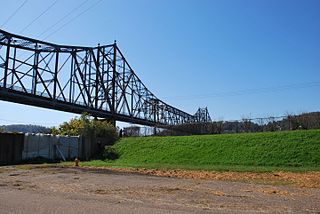
The Bellaire Bridge or Interstate Bridge is a privately owned, closed cantilever truss toll bridge that spans the Ohio River between Benwood, West Virginia and Bellaire, Ohio. It provided a link for commuters between southern Ohio border towns and West Virginia steel mills from 1926 to 1991.

Maidstone-on-the-Potomac is a historic house and farm near Falling Waters, West Virginia. Located on the Potomac River immediately opposite Williamsport, Maryland, the property consists of a 218-acre (88 ha) tract with a main house dating from c. 1741. The house was built by Evan Watkins, who operated Watkins Ferry on the Potomac, which was used by George Washington and General Edward Braddock.
Watkins House may refer to:
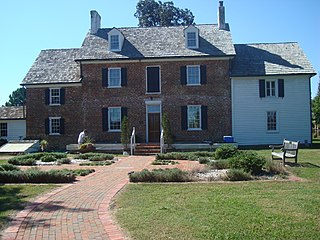
Ferry Plantation House, or Old Donation Farm, Ferry Farm, Walke Manor House, is a brick house in the neighborhood of Old Donation Farm, Virginia Beach in Virginia Beach, Virginia. The site dates back to 1642 when Savill Gaskin started the second ferry service in Hampton Roads to carry passengers on the Lynnhaven River to the nearby county courthouse and to visit plantations along the waterway. A cannon was used to signal the ferry, which had 11 total stops along the river. The first ferry service was started nearby by Adam Thoroughgood. [citation needed]

Edgewood, also known as the John Boyd House, is a historic home located at Bunker Hill, Berkeley County, West Virginia. It was built in 1839 and is a two-story, five-bay, brick dwelling with a gable roof in the Greek Revival style. The entrance features a semi-elliptical transom and sidelights. The building has a two-story rear ell. The property includes a small log slave cabin.
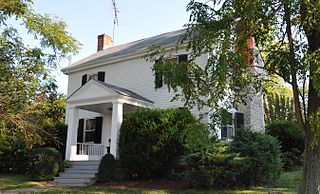
Morgan-Gold House, also known as "Golden Meadows" or the Samuel Gold House, is a historic home located at Bunker Hill, Berkeley County, West Virginia. It is an "L" shaped, three bay, two-story, log dwelling on a stone foundation. The front section was built about 1809, and is a 20 1/2-feet deep and 30 1/2-feet wide block, with a pedimented portico in the Greek Revival style. The rear part of the ell was built about 1745 by David Morgan, son of the Morgan Morgan the first white settler of West Virginia. Also on the property are three log outbuildings and Victorian-era granary.

Edward Colston House, also known as Medway, is a historic home located at Falling Waters, Berkeley County, West Virginia. It was built about 1798 and is a two-story, three-bay, gable-roofed frame dwelling. The two-story, three-bay, gable-roofed frame wing was added about 1900. It is a rare 18th-century frame building and representative of the transition from the Georgian to Federal style.

Hays-Gerrard House is a historic home located at Gerrardstown, Berkeley County, West Virginia. It was built about 1743 and is a two-story, three bay wide limestone dwelling. It measures 16 feet by 27 feet and has a steeply pitched gable roof. The property was the site of the first Baptist church in the area and home to Rev. John Gerrard, first Baptist minister west of the Blue Ridge Mountains. The house was restored in the 1970s.
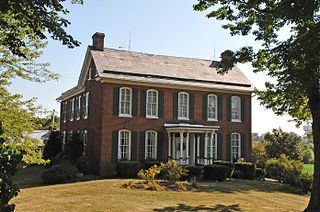
Decatur Hedges House is a historic home located near Hedgesville, Berkeley County, West Virginia. It was built in 1874 and is a two-story, five bay, "L"-shaped brick dwelling. It measures 38 feet wide by 48 feet deep and sits on a stone foundation. Also on the property is a one-story, gable roofed brick outbuilding.

Hedges-Lemen House, also known as "Fort Hill," is a historic home located near Hedgesville in Berkeley County, West Virginia, United States. It is a two-story, gable roof, limestone dwelling with a central block and wing. The central block was built in 1748 by Joshua Hedges as an Indian fort named "Fort Hill;" the wing was added in 1792. It measures 36 feet wide by 30 feet deep and the wing measures 30 feet wide by 28 feet deep. Also on the property is a stone barn and Lemen family cemetery.

Hughes-Cunningham House, also known as "HuCuRu," is a historic home located near Hedgesville, Berkeley County, West Virginia. The log and stone house is in two sections. The main section was built in 1772 and is a two-story, three bay, gable roofed log building on a stone foundation. It measures 30 feet wide by 25 feet deep. A two bay, one story stone wing was added about 1784.

James Mason House and Farm is a historic home located at Hedgesville, Berkeley County, West Virginia. The two-story stone house was built about 1809, and is a four-bay limestone building with a gable roof measuring 24 feet wide by 22 feet deep. A two-story, concrete block residential addition was completed about 1900. Also on the property is a bank barn and corn crib.

Edward Tabb House, also known as "Rural Hill," is a historic home located near Hedgesville, Berkeley County, West Virginia. It was built about 1810 and is a large Federal style rubble limestone dwelling consisting of a central block with wing. The rear section was added about 1820. The house measures 37 feet deep and 62 feet across. The entrance features a porch with paired Doric order columns and a Chippendale-style transom.

Charles Downs II House is a historic home located near Marlowe, Berkeley County, West Virginia. It was built in 1835 and is a two-story, L-shaped, brick dwelling measuring 53 feet wide and 50 feet deep. It is five bays wide and three bays deep. Also on the property are a cement block garage and wood-frame shed dating to the 1920s.

Adam Stephen House is a historic home located at Martinsburg, Berkeley County, West Virginia. It was built between 1772 and 1789, and is a 2 1/2 story, stone house measuring 43 feet, 5 inches, by 36 feet, 3 inches. It was the home of Adam Stephen. Built of shaped limestone, it stands on a prominent stone ledge, with two outbuildings in stone and log. After falling into near-ruin, iIt was restored in the 1960s by the General Adam Stephen Memorial Association and is open as a historic house museum. The house was built over a natural cave, with stone steps leading down from the basement. A local caver's organization has worked since 2002 to excavate the cave, which had become plugged with earth, and the excavation is available for tours on open house days.

Spring Mills Historic District is a national historic district located near Martinsburg, Berkeley County, West Virginia. It encompasses five contributing buildings, constructed between about 1790 and 1922, and two contributing sites. They include the Falling Waters Presbyterian Church (1834) and Manse (1922) and Stephen Hammond Mill, Miller's House, and Spring House. The buildings are of masonry construction. The sites are the Falling Waters Presbyterian Church Cemetery and the site of Dr. Allen Hammonds House.

Michael Smith House is a historic home located near Cedarville, Braxton County, West Virginia. The original section, measuring 22 feet by 19 feet, was built in 1848, and constructed of large hand-hewn logs supported by a foundation of rock pillars spaced about ten feet apart. In 1878, a log addition, 18 feet by 19 feet, was added to the west end of the log house. The house has a six-foot porch across the entire front. The house was built as part of a settlement of German immigrants.

Elmhurst, also known as The Caldwell Place, is a historic inn and tavern located at Caldwell, Greenbrier County, West Virginia. It was built in 1824 on the banks of the Greenbrier River near where a toll bridge for the James River and Kanawha Turnpike replaced a ferry crossing in 1821. It is a two-story red brick building, consisting of a 50 feet wide by 50 feet deep main section and 50 feet by 25 feet ell. It features a two-story open portico supported by four square columns and capped by an ornamental stepped gable. The listing also includes three contributing frame dependencies, a gravel approach driveway, an early 20th-century stone wall, and a portion of the original road bed of the James River and Kanawha Turnpike.

Winfield Toll Bridge, also known as the Ross Booth Memorial Bridge, is a historic three-span cantilever Warren Truss bridge located at Winfield and Red House, Putnam County, West Virginia. It was built in 1955, and spans the Kanawha River, carrying West Virginia Route 34. The cantilever through-truss consists of two anchor spans each 245 feet (75 m) in length and the main span 462 feet (141 m) in length between pier center lines. The main span consists of two 128-foot-4-inch (39.12 m) cantilever arms and a 205-foot-4-inch (62.59 m) suspended span.



















